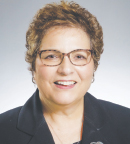Although it has long been known that certain cancer types disproportionately affect individuals from underserved and underrepresented populations, the sources of these disparities are still not entirely clear. In a “Facebook Live” session at the 2017 American Association for Cancer Research (AACR) Conference on the Science of Cancer Health Disparities in Racial/ Ethnic Minorities and the Medically Underserved in Atlanta, an expert panel discussed the major themes from the meeting and tackled the daunting issue of closing the gap.

There are a lot of cancer cell lines and animal models out there, but very few of them have been derived from patients from underrepresented populations.— John Carpten, PhD
Tweet this quote
“This conference was developed as a platform for us to come together and talk about the research and science, but most important, to make sure we’re disseminating this information and sharing it with community advocates and survivors,” said John Carpten, PhD, moderator of the session and Director of the Institute of Translational Genomics at the Keck School of Medicine, University of Southern California Los Angeles. “There was a feeling here this year, an excitement that we’re finally beyond just sustaining as a discipline; we’re now growing as a discipline.”
Multilevel Disparities in Breast Cancer
Christopher Li, MD, PhD, of Fred Hutchinson Cancer Research Center in Seattle, discussed breast cancer disparities across a number of underserved communities. “Women who are poor, uninsured/underinsured, or less educated, as well as African American and Latina women, all have higher rates of dying from breast cancer and are about 30% to 60% less likely to get the types of treatment that we all agree is the standard of care for their disease,” said Dr. Li. “These disparities are unacceptable, and if we could just deliver quality care to these women, we could potentially eliminate some of these differences in mortality.”

Christopher Li, MD, PhD
He explained that these disparities operate on a variety of levels, including the patient level (ie, lack of insurance or access to a hospital that offers necessary treatment, delays in treatment due to overutilization), the physician level (ie, is care approached in a culturally appropriate way? Is language about treatment communicated in a manner in which all patients can understand?), or the hospital level (ie, are the necessary resources available both to treat and follow up with patients?) Addressing these multilevel disparities is particularly crucial in breast cancer, with its large numbers of survivors, he noted.
According to Dr. Li, a concerted effort is needed to better prevent, diagnose, and treat the cancers that disproportionately affect the underserved. “It’s like a bucket with a lot of leaks,” he said. “We can plug one of the holes related to the patient, but then the other ones related to the doctors or the hospitals are still going to lead to these disparities.”
Why Aren’t We Preventing Cervical Cancer?
In the realm of cervical cancer, significant progress has been made through the development of vaccines and screenings, but issues with the dissemination of these tools and technologies continues to result in cancer health disparities.

The good news is we have a vaccine for HPV. The bad news is we’re not taking advantage of it.— Electra Paskett, PhD
Tweet this quote
According to Electra Paskett, PhD, of The Ohio State University Comprehensive Cancer Center in Columbus, “the good news is we have a vaccine for human papillomavirus (HPV). The bad news is we’re not taking advantage of it.” Fewer than 50% of 13-year-old females in the United States are up-to-date with their HPV vaccinations, and the rate is even lower among males. “We need to have a concerted effort to increase those rates,” said Dr. Paskett. “We have a vaccine to prevent at least six cancers. We need to use it.”
Addressing disparities in cervical cancer is a process that does not end with the HPV vaccine. “Abnormal screenings need to be followed up, and that’s where we tend to lose women through the cracks, particularly in low income, minority, and rural populations,” she said. “We’re not helping the cause when we get people in for screening and then we have no way to assure they receive the follow-up care needed.”
The Issue of Funding
Addressing cancer disparities requires money. According to H. Nelson Aguila, DVM, Deputy Director of the National Cancer Institute (NCI) Center to Reduce Cancer Health Disparities, the investment made in cancer in the United States has led to improved detection and treatments, as well as a 25% reduction in cancer deaths over the past 2 decades. But not all populations are benefiting from these advancements in cancer research.

H. Nelson Aguila, DVM
According to Dr. Aguila, more research on disparate biologic and nonbiologic factors in underrepresented racial/ethnic minorities is needed to mitigate, and ultimately eliminate, cancer health disparities. “Also, it’s critical they participate in clinical trials,” he said, adding that the NCI is committed to funding disparity health research and increasing diversity in the biomedical workforce.
Dr. Carpten noted upcoming scientific opportunities from the Center to Reduce Cancer Health Disparities, including a U54 for creating model systems for patients from underrepresented populations. “There are a lot of cancer cell lines and animal models out there, but very few of them have been derived from patients from underrepresented populations,” he explained. “So when we use these models to try to understand the biology of these cancers, we’re not necessarily capturing the full context given various genetic backgrounds. We’re really excited that the NCI has stepped up to help us learn more about the differences that we see in these tumors.”
Increasing Minority Enrollment in Clinical Trials
Mary Jackson Scroggins, a 20-year ovarian cancer survivor, health activist, and member of the AACR Minorities in Cancer Research Council, said she had ovarian cancer symptoms for over 2 years but was told it was likely menopause. “I was diagnosed by chance, not because of my symptoms,” she told the Facebook audience.
“At the time, some African American women were being told we didn’t have to worry about ovarian cancer, that we didn’t really get it, or we got it so rarely we shouldn’t concern ourselves,” she said. “The truth is we aren’t diagnosed as often, but if we are diagnosed, we’re much more likely to die of it.”

Mary Jackson Scroggins
She stressed the importance of a diverse representative clinical trial population. “The fact that African American women weren’t considered to be at risk indicates we probably weren’t in very many trials,” she said. “The trial population ought to be similar to the real-world population who are likely to benefit, and I think the people who are making the decisions about which trials will move forward and how they will accrue and who they will accrue ought to look like the real population as well.”
According to Dr. Li, federal funding must be continuously pursued to support the work involved in addressing cancer health disparities, but the current climate also lends itself to creativity in pursuing partnerships with nonprofits and advocacy organizations that can help to facilitate research or with industry and others that share the same mission. “We don’t want to let up on the rate or on the progress that we’re making,” he told The ASCO Post. “We want to keep all of the doors open.” ■
DISCLOSURE: Drs. Li, Carpten, and Aguila reported no conflicts of interest. Dr. Paskett is a grantee from Merck Foundation.

